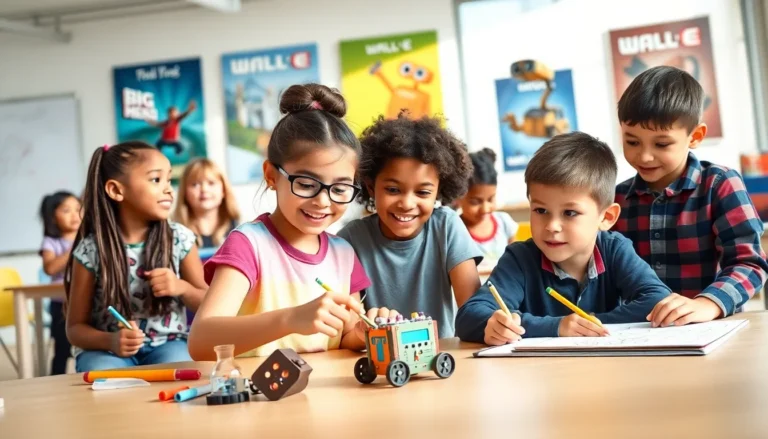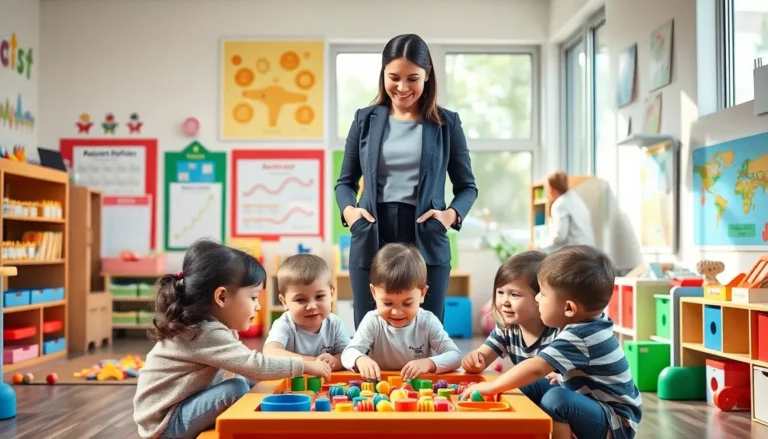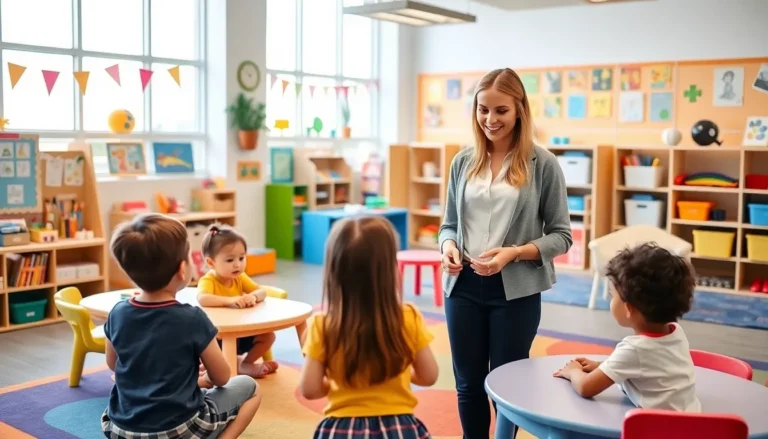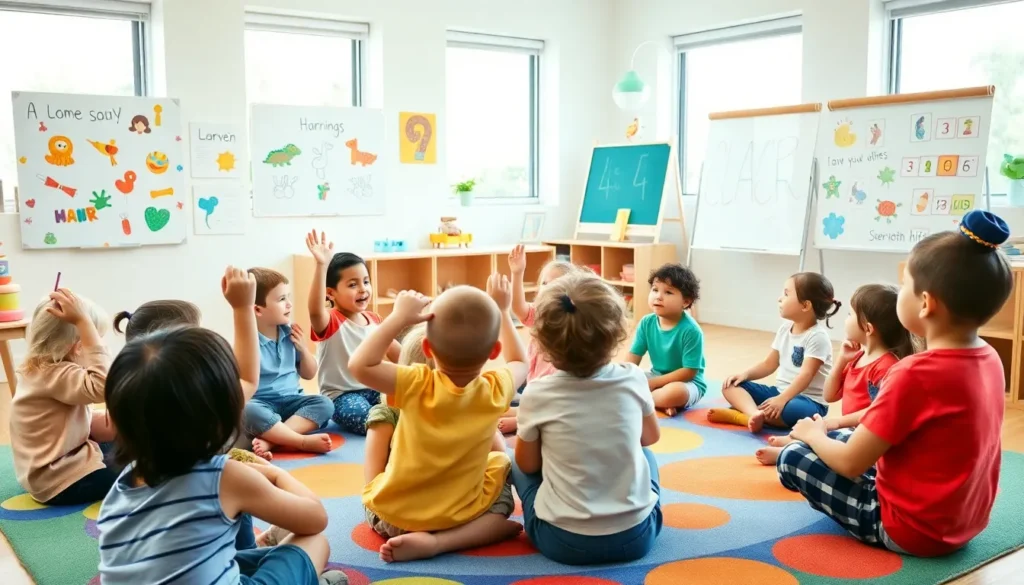Table of Contents
ToggleCircle time in preschool isn’t just a cozy gathering: it’s where magic happens. Imagine a space filled with laughter, colorful stories, and tiny hands eagerly raising to share their thoughts. As crucial as nap time (and a lot more fun), circle time provides a unique opportunity for preschoolers to learn, socialize, and express themselves. With the right mix of structure and creativity, it can turn into the highlight of the day, making even the shyest child feel special. So, let’s jump into the wonderful world of circle time and discover how it fosters connections and ignites imaginations.
What Is Circle Time?

Circle time is a dedicated period during the preschool day where children sit together in a circle to engage in various activities. It often incorporates stories, songs, games, and discussions that promote interaction among peers and teachers. This concept encourages children to share, take turns, and develop their listening skills. But, circle time is more than just a routine: it lays the groundwork for social skills and cognitive development.
At its core, circle time is about connection. Kids get to see each other’s faces, build rapport, and establish friendships. It’s their first taste of group dynamics, allowing them to understand the importance of collaboration. Whether sharing a thought about a book or singing a tune, circle time is a vibrant portal to learning and community.
Benefits of Circle Time for Preschoolers
The benefits of circle time extend far beyond just having fun. Here’s a rundown of how it enriches preschoolers’ learning experiences:
- Social Skills Development: Sitting in a circle teaches children to communicate effectively. They learn to wait their turn, listen attentively, and respect different opinions.
- Language Development: Through songs, stories, and discussions, children expand their vocabulary and language skills. They become comfortable expressing their thoughts out loud.
- Attention and Focus: Circle time encourages children to focus on the task at hand. Engaging activities help improve their attention span, which is essential for future learning.
- Emotional Growth: Sharing feelings and experiences helps kids understand and express their emotions. This is critical for emotional intelligence, which they will carry into their lives.
- Cognitive Development: Activities like counting games or storytelling stimulate critical thinking and problem-solving skills, essential components of early education.
So, circle time serves as a fantastic foundation for developing well-rounded, confident children.
Components of an Effective Circle Time
An effective circle time is well-structured yet flexible. Key components include:
- Warm Greetings: Start with a friendly greeting that sets a positive tone. This helps everyone feel included and excited about the session ahead.
- Structured Activities: Incorporating a mix of stories, songs, and discussions helps maintain interest and keeps children engaged.
- Visual Aids: Utilizing books, puppets, or props captivates attention and enhances storytelling, allowing children to envision and interact with the material.
- Interactive Participation: Actively involving children makes them feel valued. Encourage them to share their ideas and participate in discussions.
- Routine Consistency: Having a consistent schedule helps children know what to expect, ensuring a smooth transition from one activity to another.
These elements combine to create a nurturing environment where learning can flourish.
Activities to Engage Preschoolers During Circle Time
Engaging activities can make circle time a highlight of the preschool day. Here are some ideas to electrify the atmosphere:
- Storytime: Choose vibrant books that encourage participation. Invite children to predict what happens next or to act out the story.
- Songs and Fingerplays: Incorporate catchy songs or fingerplays that prompt movement and interaction. This fosters physical engagement while expanding their vocabulary.
- Show and Tell: Allow children to bring in items from home to share. This not only boosts confidence but also encourages listening and questions.
- Movement Games: Incorporate simple games that involve clapping, dancing, or moving in place. This will break the ice and burn off some excess energy.
- Themed Discussions: Select a topic for each week where kids can share their thoughts. This could be anything from ‘favorite animals’ to ‘what makes them happy’.
With these activities, circle time becomes an enjoyable and dynamic learning experience.
Tips for Conducting Successful Circle Time
Creating a successful circle time requires some foresight and adaptability. Here are some helpful tips:
- Set Clear Expectations: Before starting, explain the rules and expectations. This smoothens the transition into activities and establishes boundaries.
- Be Flexible: While having a planned agenda is great, staying flexible to the children’s needs is equally important. If they express interest in a certain topic, go with it.
- Use a Timer: Keeping activities time-bound helps maintain focus. It also assists children in transitioning between different tasks more efficiently.
- Engage with Enthusiasm: Your energy sets the atmosphere. Bringing excitement and enthusiasm encourages children to participate actively and joyfully.
- Reflect and Adjust: After each circle time, take note of what worked well and what didn’t. Continuously refining your approach will ensure a more effective learning environment.
Common Challenges and Solutions
Even though circle time is beneficial, it can come with its own set of challenges. Here are some common issues and how to tackle them:
- Attention Span Issues: Young children often have short attention spans. Solution: Break up the time with shorter activities, changing the focus every 5-10 minutes to keep them engaged.
- Uneven Participation: Some kids dominate the conversation while others remain silent. Solution: Carry out a talking stick or a similar method to ensure everyone gets a chance to speak.
- Disruptive Behavior: Circumstances can arise where children become rowdy. Solution: Have clear, consistent consequences for disruptive behavior, but also ensure to redirect their energy with a quick movement break.
- Variety Fatigue: Children may lose interest if activities become repetitive. Solution: Regularly introduce new songs, stories, and games to keep things fresh and invigorating.
By addressing these challenges proactively, circle time can remain an enriching experience for everyone.







